Premium
Drought: Millions go hungry as Aberdare battles inferno

Mr Abdi Boru shows carcasses of cows that have died due to drought in Dabel village, Marsabit County on August 24, 2022.
An inferno that has been raging in Aberdare forest for the past two weeks is yet to be put under control.
This is happening as more than two million more Kenyans get affected by drought and hunger, bringing the total to about six million.
The blaze, which started in Satima, Nyandarua County, has destroyed more than 40,000 acres of vegetation.
A Kenya Wildlife Service (KWS) helicopter took an NTV crew on a tour of the Aberdare Na-tional Park on Friday to witness the effects of the fire that has also affected animals.
The strong winds and dry vegetation have made efforts to contain fires difficult.
KWS Mountain Conservation Area Assistant Director, Bakari Chongwa, said the rangers are do-ing all they can to control the fires, which have consumed huge tracts of moorland.
The rangers said the fires were caused by illegal human activities, adding that culprits would be arrested and brought to book.
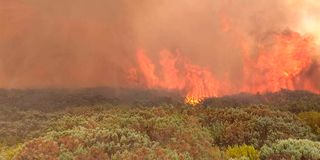
A fire razes Aberdare forest on Friday. KWS says the fire started early in the week.
Mr Chongwa said two people had died in incidents related to the fires.
In addition to the KWS officers fighting the blaze on the ground, the government has hired the services of a plane with a capacity of 2,000 litres of water.
According to Mr Chongwa, the economic and environmental impacts of the fires in Aberdare and Mt Kenya forests will be felt for long.
Another fire was consuming Mau forest for the third day yesterday.
The Ministry of Environment, Forestry and Climate Change says the country has recorded 180 woodland fire incidents in the last two months alone.
The fires come as Kenyans continue to suffer from hunger.
Erratic rains have not spared traditional food secure areas of Mt Kenya that are now relying on relief supplies.
According to the latest report by Kenya Food Security Steering Group (KFSSG), the number of Kenyans affected by drought and hunger has increased drastically from 4.2 million to six million.
The report adds that more than 970,000 children aged five and below and 142,000 pregnant and lactating women require urgent treatment for malnutrition, up from 884,000 reported in July last year.
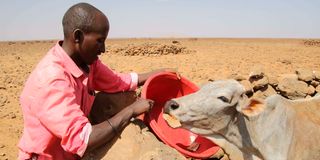
Wato Dambala feeds one of his cows on pieces of carton due to lack of pasture in Tigo village, Marsabit County, on February 10, 2023. More than 300,000 are in urgent need of food.
The increase follows a fifth consecutive season of poor rainfall, with the number of people requir-ing humanitarian assistance going up to 4.4 million from 3.5 million, a clear show of the impact the drought has had on food security in the 23 arid and semi-arid land counties.
President William Ruto has urged well-wishers, private entities and partners to support the gov-ernment in building long term resilience to drought, while promising to spend the resources dili-gently.
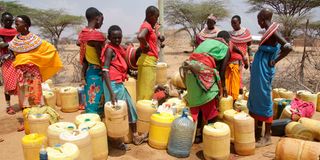
Women crowd at a common water point in Ngutuk Ongiron village, Samburu County, on February 8. They walk long distances in search of water due to the ongoing drought.
“We face a devastating drought that has led to distress and suffering. This crisis is growing worse and requires urgent scaling up of interventions,” the President tweeted.
“We call on partners, the private sector and well-wishers to step forward and support us in saving lives and building long-term resilience. Kenya commits to fully account for the donated re-sources.”
The KFSSG recently announced that it needs Sh15.35 billion for the March-May drought re-sponse.
The response involves enhancing food assistance through cash transfers, interventions on nutri-tion, water, livestock feeding, school feeding programmes, peace and security and recovery of agriculture from the raging drought.
Turkana, Marsabit, Mandera, Isiolo, Garissa, Baringo and Samburu are the most affected regions in the country.
Turkana, with a population of 1,022,773, leads in the number of people in need of assistance af-ter the 2022 short and long rainy seasons failed.

A woman fetches water from River Nyariginu amid a drought in Laikipia County, February 16, 2023.
Other counties are Wajir, West Pokot, Laikipia, Kajiado, Kilifi and Kwale.
Because of the drought, some 500,000 more people have become food insecure in Machakos, Homa Bay, Migori, Siaya, Elgeyo Marakwet, Kiambu, Nakuru, Kirinyaga and Murang’a coun-ties.
Residents of Kinanie, Kivaa, Kithyoko, Ekalakala, Masinga central, Kalama, Kathiani, Ngelani, Mitaboni, Mumbuni, Katheka Kai, Matungulu, Kibaoni, Muthetheni, Wamunyu, Matuu, Katangi, Ndalani, Kithimani, Ikombe and parts of Kangundo East in Machakos County are struggling to access food.
The most affected areas in Homa Bay are Rachuonyo North and Suba North.
In Migori, Kuria East and Nyatike have been identified as hunger hotspots, while Bondo and Rarieda in Siaya also make it to the list.
Marakwet East, Marakwet West, Keiyo North and Keiyo South in Elgeyo Marakwet have been listed as hunger hotspots, with Bibirioni, Ndeiya, Karai and Nachu identified in Kiambu.
The worst affected areas in Nakuru County are Rongai, Molo, Subukia, Bahati, Njoro, Kuresoi North, Kuresoi South, Naivasha and Gilgil as are Murinduko, Kangai, Nyangati, Thiba, Wamumu, Mwea and Tebere in Kirinyaga.
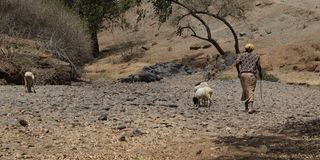
A woman herd her animals amid a drought in Laikipia County on February 16, 2023.
The areas listed as food insecure in Murang’a are Kiharu, Gatanga, Maragwa and Kandara.
The hunger is blamed on below average crop production and the deteriorating body condition of livestock that has led to 2.6 million deaths and loss of more than Sh100 billion.
Insecurity fuelled by banditry and drying up of more than half of the country’s water sources have also contributed to lack of food.
Even as the government plans to send food and scale up cash transfers, provide supplementary feeding to children and conduct other interventions, the nutrition situation is likely to get worse in the next three months as drought persists.
The Meteorological Department has predicted normal to below-normal performance in March and April.
“Household incomes from crop sales are expected to be below average and are likely to limit ac-cess to seeds, fertiliser and other inputs for the March to May long rains cropping season,” the Department says in its report.
“This will mean below average acreage under food crops. Due to the peace and security situation, access to dry season grazing areas with pasture and water resources remains a challenge and may further compound livestock body condition and mortality rates.”
Learning in schools is also likely to be affected as families lose purchasing power, ultimately hit-ting their ability to pay fees and retain children in school.
Many households are already struggling with sanitation because of lack of water.
Livestock may continue to die due to deteriorating body conditions and scarce resources.
The government has spent more than Sh32 billion on cushioning Kenyans from the effects of the ongoing drought.

The effects of the drought in Laikipia County as pictured on February 16, 2023.
This includes Sh4.9 billion spent since September 2022 in immediate life-saving interventions and Sh1.44 billion in cash transfers under the Hunger Safety Net Programme (HSNP).
More than half of Samburu County residents are in need of urgent support in the wake of the prolonged drought, the Kenya Red Cross Society (KRCS) says.
KRCS Deputy Secretary-General Annette Msabeni, said 55 per cent of the population in the county is in need of support as the dry region endures one of the worst droughts in many dec-ades.
“Samburu is one of the most affected counties by the drought,” Ms Msabeni said.
Laisamis and North Horr sub-counties are the most hit in Marsabit, with many residents reported-ly fainting due to hunger.
National Drought Management Authority (NDMA) Marsabit Coordinator, Henry Mustafa, said more than 300,000 residents are acutely food insecure and have been left at the mercy of aid agencies.
At least 30,000 children below five and 10,000 lactating mothers are acutely malnourished.
These numbers are likely to rise with the continued worsening of the drought.
It has been predicted by the Meteorological Department that the dry spell in Marsabit is likely to extend up to August.
In Isiolo, the Catholic Relief Services has partnered with Caritas Isiolo and the devolved gov-ernment to roll out livestock feed distribution to pastoralists in five wards badly hit by the drought.
A consignment of 100 tonnes of range cubes was flagged off for distribution to more than 800 pastoralist households in Cherab, Chari, Sericho, Oldonyiro and Garbatulla – areas the NDMA has flagged as the most affected.
A week after the government suspended irrigation to allow uninterrupted river flows in Laikipia, locals in the lower parts of the county are accusing the Water Resources Authority (WRA) of sleeping on the job.
Those affected by the drying up of rivers have threatened to take the law into their hands by de-stroying points diverting water for irrigation.
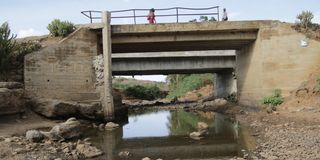
The effects of the drought in Laikipia County as pictured on February 16, 2023.
“We have given WRA officials three days to order the farmers to release the water, failure to which we shall walk there and destroy these intakes,” said Mr Mawira Mutembei at Ngareng’iro shopping centre, referring to the drying up of River Ewaso Ng’iro.
Officials from the Ministry of Water visited the county last week over looming water-related conflicts and suspended irrigation.
Reported by Mercy Chelangat, Maggie Kimathi, Geoffrey Ondieki, Jacob Walter, Mwangi Ndirangu and Waweru Wairimu





